
Life of Christ (part one): Gospels; Nativity; Backgroud; Baptism; John the Baptist; Disciples
The Four Gospels
There are four gospels. Matthew, Mark and Luke are called the synoptic (from the Greek words “syn” meaning “together” and “opsis” meaning “seeing”) gospels. The synopitic gospels tend to focus on Jesus public ministry and teaching in Galilee while the fourth gospel, John, provides us with details of the divine side of Jesus with emphasis on his private teaching to his disciples and the majority of the book occurs in Judea.
Matthew
In Matthew Jesus is presented as the Messiah-King (the lion).
Book |
Matthew |
Author |
Mathew, one of the twelve apostles, (also called Levi, Lk. 5:27), a Jew who collected taxes for the Romans from the Jews |
Date |
50 AD, first recorded quoted in 110 AD by Ignatius |
Earliest
Existing
Manuscript |
66 AD or earlier - Magdalen Papyrus (P64) contains Mat. 26:7-8, 10, 14-15, 22-23, 31
66 AD – Barcelona Papyrus (P67) contains Mat. 3:9, 15; 5:20-22, 25-28 |
Audience |
Matthew was written with the Jew in mind |
Purpose |
Demonstrate that Jesus was the Jewish Messiah |
The church history Eusebius (ca. 325 AD) quoted Origen (ca. 220 AD) when he said:
“Among the four gospels, which are the only indisputable ones in the Church of God under heaven, I have learned by tradition that the first was written by Matthew, who was once a publican, but afterwards an apostle of Jesus Christ, and it was prepared for the converts from Judaism.”
Since this gospel was addressed to the Jews Matthew begins Jesus’ genealogy with Abraham and brings it through King David. This is to prove that Jesus is the King of Israel. Matthew avoids speaking the name of God which would offend the Jews and so he calls Jesus the Son of David instead of the Son of God and the Kingdom of God (used four times) is referred to as the Kingdom of Heaven (thirty-four times). Matthew mentions Jewish customs with out explaining them indicating his readers were familiar with them which also indicates a Jewish audience. Matthew uses over 129 Old Testament quotes, references or images.

Matthew is unique in addressing the church (16:18; 18:17) and Gentiles (wisemen, centurion, Canaanite woman, 24:14, 28:19)
Chapter |
Organization of Matthew |
Chapter 1-10 |
Jesus presents himself to the Jews as their King |
Chapter 11-13 |
The Jewish leaders reject Jesus |
Chapter 14-20 |
Jesus withdraws from crowd and prepares his disciples |
Chapter 21-27 |
Jesus is rejected by the Jewish nation but rises from the dead to send the Jewish disciples to the Gentile nations |
Chapter |
Narrative Chapters |
Five Discourses Recorded by Matthew |
1:1- 2:12 |
Introduction |
|
2:13-23 |
Foundation of Kingdom |
|
5:1-7:29 |
|
Sermon on the Mount |
8:1-10:4 |
Proclaiming the Kingdom |
|
10:5-11:1 |
|
Evangelism & Discipleship |
11:2-12:49 |
Conflict with the Kingdom |
|
13:1-52 |
|
Parables of the Kingdom |
13:53-17:27 |
Preparing for the Gentiles |
|
18:1-19:2 |
|
Life and Character of the Kingdom |
19:3-23:39 |
Final Conflict and Rejection |
|
24:1-25:46 |
|
Eschatology: The Coming of the Kingdom |
26:1-28:20 |
Crucifixion and Resurrection |
|
|
|
|
Temptations from Satan and the World to Eve, Jesus and Us |
Temptation |
Genesis 3:6 |
Matthew 4 |
First John 2:16 |
Physical appetite |
“When the woman saw that the fruit of the tree was good for food. . .” (3:6) |
“Tell these stones to become bread” (4:3) |
The cravings of sinful man (2:16) |
Personal Gain |
“. . . and pleasing to the eye. . .” |
“Throw yourself down . . . they (angels) will lift you up in their hands.” (4:5) |
The lust of his eyes |
Power and Glory |
“ . . . and also desirable for gaining wisdom, she took some.” |
“. . .showed him all the kingdoms of the world and their splendor. ‘All this I will give you.’ ” (4:8) |
Boasting of what he has and does |
Jesus’ Six Trials
|
When |
Where |
Verse |
- Annas
|
About
2:30 A.M |
High Priest’s House/Palace |
John 18:12-14 |
- Caiaphas
|
About
3:00 A.M. |
High Priest’s House/Palace |
Matt. 26:57-68 |
- Sanhedrin
|
Sunrise
5:15 |
Temple |
Matt. 27:1-2 |
- Pilate
|
About
6:00 A. M. |
Fort Antonia
(Praetorium) |
John 18:28-38 |
- Herod
|
About
6:45 |
Herod’s Palace |
Luke 23:6-12 |
- Pilate
|
7:30-8:30 AM |
Fort Antonia
(Praetorium) |
John 18:39-19:6 |
The Seven Kingdom Parables
Parable |
Illustrates Basic Truth of the Next Phase of the Kingdom of Heaven in the earth –
The Church Age |
Scripture |
1 |
The Sower and the Seed |
Growth during this next phase of the Kingdom of God will be based on receiving & responding to the Word (seed) which will then cause growth and production |
Mt.13:3-9; 18-23 |
2 |
The Sowing of the Weeds |
False imitation “seeds” or teaching will also be sown and allowed to grow and develop during this next age |
Mt. 13:24-30; 37-43 |
3 |
The Mustard Seed |
Growth of the church in this dispensation during this time will be from the smallest group to the largest group |
Mt. 13:31-32 |
4 |
The Yeast |
Once this truth is mixed into the world, even in the smallest amount, it will spread through out the whole world into every nation and into every level of society. |
Mt. 13:33 |
5 |
The Hidden Treasure |
Israel is the treasured nation and though it is set aside (hidden in the field or earth), when the whole field has been purchased the treasure (Israel) will be dug up again |
Mt. 13:44 |
6 |
The Pearl |
The Lord (merchant) has been trying to gain the nations (pearls). Now with this plan he can gain all of them at once in the church age after he has sold everything on the cross |
Mt. 13:45-46 |
7 |
The Net |
At the end of this age the next event is the day of judgment or the separating of people like separating good & bad fish. |
Mt. 13:47-50 |
Twenty Mysteries Revealed in the New Testament by Jesus, Paul or John
The Greek word for “secrets” or “mystery” is “mysterion” and it referred to __________________
- Matthew 13:11 – “The knowledge of the secrets of the kingdom of heaven. . .”
- Luke 8:10 – “The knowledge of the secrets of the kingdom of God . . .”
- Romans 11:25 – “I do not want you to be ignorant of this mystery. . . Israel has experienced a hardening in part until . . . “
- Romans 16:25-26 – “. . . my gospel . . . according to the revelation of the mystery hidden for long ages past, but now revealed. . . “
- 1 Corinthians 4:1 – “Servants of Christ . . . those entrusted with the secret things of God.”
- Ephesians 1:9 – “He made known to us the mystery of his will. . .”
- Ephesians 3:2-3 – “. . . the administration (dispensation) of God’s grace . . . that is the mystery made known to me by revelation.”
- Ephesians 3:4 – “In reading this, then, you will be able to understand my insight into the mystery of Christ which was not made known to men in other generations . . . “
- Ephesians 3:9 – “. . . make plain to everyone the administration (dispensation) of this mystery, which in ages past was kept hidden in God.”
- Ephesians 5:32 – “This is a profound mystery – but I am talking about Christ and the church.”
- Colossians 1:26 – “. . .the mystery that has been kept hidden for ages and generations, but is now disclosed to the saints.”
- Colossians 1:27 – “. . . make known among the Gentiles the glorious riches of this mystery, which is Christ in you, the hope of glory.”
- Colossians 2:2 – “. . . that they may know the mystery of God, namely, Christ, in whom are hidden all the treasures of wisdom and knowledge.”
- Colossians 4:3 – “Pray for us . . . that we may proclaim the mystery of Christ.”
- 2 Thessalonians 2:7 – “For the secret power of lawlessness is already at work.”
- 1 Timothy 3:9 – “They must keep hold of the deep truths (“mysterion”) of the faith with a clear conscience.”
- 1 Timothy 3:16 – “The mystery of godliness is great.”
- Revelation 1:20 – “The mystery of the seven stars . . and of the seven golden lampstands is this. . .”
- Revelation 10:7 – “In the days when the seventh angel is about to sound his trumpet, the mystery of God will be accomplished.”
- Revelation 17:5 – “Mystery - Babylon the Great -The Mother of Prostitutes and of the Abominations of the earth.”
Mark
In Mark Jesus is presented as Jehovah’s Servant (the ox)
Book |
Mark |
Author |
Mark |
Date |
57-59 or even 63 AD |
Earliest
Existing
Manuscript |
68 AD (could be 50 AD) Dead Seas Scroll MSS 7Q5 contains Mark 6:52-53 |
Audience |
Written in Rome for the Roman Christians |
Purpose |
To encourage the believers in the city of Rome by reminding them of Jesus, the Lord and Savior, with the message his life revealed. |
In all the writings of the earliest church fathers Mark is the accepted author. Writing around 110-140 AD Papias, the bishop of Hieropolis, quotes his teacher, the apostle John, as saying that Mark traveled with Peter, listened to him teach, accurately, but not chronologically, recorded what Peter remembered and then interpreted and translated Peter’s Aramaic teaching into Greek. Papias’ understanding is confirmed by Justin Martyr who described it as “the memoirs of Peter” (160), Irenaeus who called Mark “the disciple and interpreter of Peter” (180), Clement of Alexandria (195), Tertullian (200) and Origen (230). Mark is mentioned in scripture as John Mark in Acts 12:12, 25; 13:5, 13; 15:37, 39; Col. 4:10; 2 Tim. 4:11; Philemon 24; 1 Peter 5:13. In Mark 14:51,52 John Mark records a story that included himself the night of Jesus’ arrest. John Mark’s mother’s house was where the early Jerusalem church met and may have been the location of the last supper. Peter refers to John Mark as “my son” in 1 Peter 5:13.
Mark’s book is a “gospel”, or “”euangelion”, from the first century Roman and Greek world. The word “euangelion” was adapted by the New Testament writers but not developed by them. In the Greek and Roman world “euagnelion” was a technical term for a message of military victory and also referred to joyful information concerning political and personal success. When the good message, or “euangelion”, was heard and received the gods where thanked and sacrifices were offered. Anytime the divine emperor sent out a decree, made a speech or performed some deed the information of this event was “euangelion” or the “gospel” of the emperor or king. As Mark writes his book he is recording the “euagelion” of Jesus Christ. Mark is trying to capture the message or the decree of Jesus. Since Mark is recording the context of the gospel and not writing the history of Jesus Christ chronological order is not necessary.
This book, the shortest of the four gospels, was not written for Jews but as a source of encouragement for believers. It was not written in Judea since Mark seems to focus on communicating with people unfamiliar with Jewish customs and the land:
- Aramaic (the language of Judea which Peter, Jesus and others spoke) is translated into Greek (the language of the Greek world Rome had conquered) in 3:17; 5:41; 7:11, 34; 9:43; 10:46; 14:36; 15:22, 34.
- There are places Latin (the original language of Rome) words are used instead of the expected Greek. (5:9; 6:27; 12:15, 42; 15:16, 39)
- References to the time of day are Roman as in 6:48; 13:35.
- Jewish customs are explained in 7:3-4; 14:12; 15:42.
- Compared to Matthew, the Old Testament are not referred to as frequently.
- The man who carried Jesus cross, Simon of Cyrene, is identified as the father of Alexander and Rufus (15:21) who resided in the Rome according to Romans 16:13.
- Also, note there is no Jewish genealogy given for Jesus.
A quote from Papias, a disciple of the apostle John, concerning Mark and his book:
“The Apostle John said this: Mark having become the interpreter of Peter, wrote down accurately whatsoever he remembered. It was not, however, in exact order that he related the sayings or deeds of Christ. For he neither heard the Lord nor accompanied Him. But afterwards, as I said, he accompanied Peter, who accommodated his instructions to the necessities of his hearers, but with no intention of giving a regular narrative of the Lord’s sayings. Wherefore Mark made no mistake in this writing some things as he remembered them. For of one thing he took especial care, not to omit anything he had heard, and not to put anything fictitious into the statements.” (http://www.earlychristianwritings.com/text/papias.html)
Jesus is not presented primarily as the king of the Jews but instead, like Mark’s Roman readers, Jesus is presented as the servant and is often seen suffering for his service. Jesus’ human side is presented clearly and in detail with Mark’s gospel:
- 1:41 – Jesus was “filled with compassion”
- 3:5 – Jesus “looked around at them in anger and, deeply distressed”
- 6:34 – Jesus “had compassion on them.”
- 8:12 – Jesus “sighed deeply and said, ‘Why does this generation ask for a miraculous sign?’ ”
- 4:38 – “Jesus was in the stern, sleeping on a cushion”
- 11:12 – “The next day as they were leaving Bethany, Jesus was hungry.”
- 10:13-16 – “People were bringing little children to Jesus to have him touch them, but the disciples rebuked them.”
Mark places an emphasis on what the servant Jesus did and less on his parables and teaching discourses.
The book of Mark broken up into three time periods:
- The first three years – 1:1-8:26, or 8 chapters for 3 years
- The next six months - 8:27-10:52, or 2 ½ chapters for 6 months
- The last eight days – 11:1-16:20, or 6 chapters for 8 days
Luke
In Luke Jesus is presented as the Son of Man (the man)
Book |
Luke |
Author |
Luke, the only Gentile to write scripture in OT or NT |
Date |
60-62 AD |
Earliest
Existing
Manuscript |
66 AD Paris Papyrus (P4) – contains Luke 3:23; 5:36 |
Audience |
Gentiles |
Purpose |
Communicate a complete, orderly account of salvation available to both the Jews and the Greeks through Jesus Christ. |
According to Eusebius and Jerome, Luke was from Antioch in Syria. Paul calls him a physician in Colossians 4:14. Luke places an emphasis on Jesus’ physical healing ministry.
Luke begins both the Gospel of Luke and the book of Acts by addressing them to Theophilus. Since the book of Acts ends with Paul in prison in Rome it is a good assumption to conclude that Luke wrote both his gospel and the book of Acts during Paul’s two years in Rome under house arrest which would have been 60-62 AD. Theophilus is addressed as “most excellent” which would indicate he was a Roman dignitary and it is even possible he was a member of the household of Caesar himself (Philippians 4:22). Theophilus was a Roman official who may have financed the production of Luke’s two volume set.
Luke carefully researched the events of the Life of Christ and interviewed eye witnesses to the events. (1:2-3) His notes were carefully copied and then arranged into the book of called by his name. Although at the time of Luke’s writing he states that there were already many accounts (1:1) concerning Jesus’ life and deeds already written (it is interesting that the only gospel written at that time was Matthew, so there must have been many more that have not made their way through the years), it appears that Luke did not use any of them, but instead spoke to eye witnesses and “carefully investigated everything from the beginning.” The word “carefully investigated” is the Greek word “parakoloutheo” and it means “to follow or accompany closely; to attend; to follow with thought.” As you read the account of the nativity beginning with Zechariah and the birth of John the Baptist until Joseph flees with his family into Egypt you should wonder if it was Mary herself (present in the upper room on the Day of Pentecost in Acts 1, 2) that told Luke the details he writes.
Luke writes with a very high level of Greek similar to classical Greek and the Septuagint. His writing is equal to the historians giving attention to historical details that in return today give Luke’s authenticity rich credibility.
After the account of Jesus’ birth, Luke’s gospel is arranged in three sections:
- Jesus’ ministry in Galilee – 4:12-9:50
- Jesus’ ministry in Judea and Perea – 9:51-19:27
- Jesus’ final week in Jerusalem – 19:28-24:53
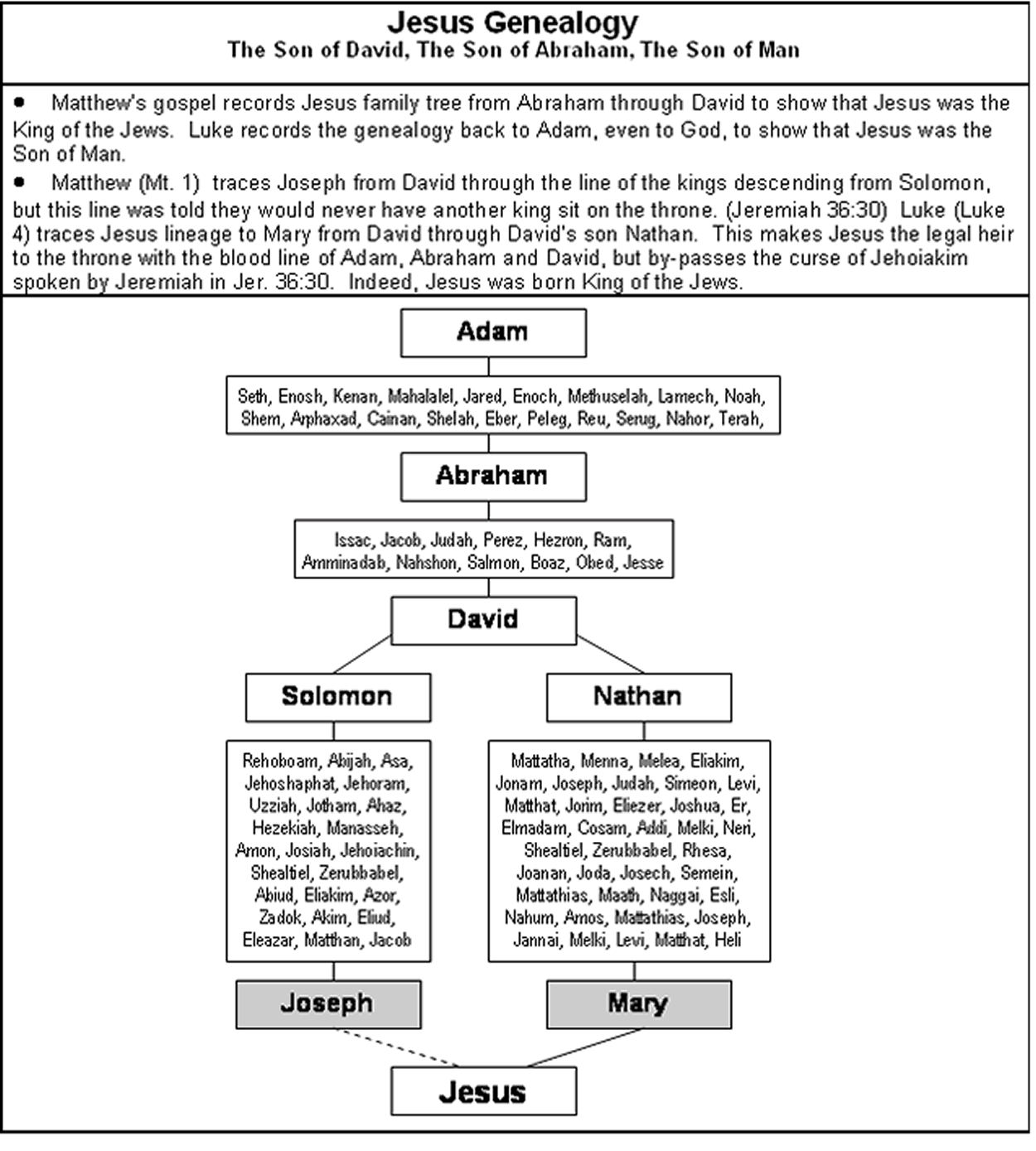
John
In John Jesus is presented as the Son of God (the eagle)
Book |
John |
Author |
John |
Date |
85 AD |
Earliest
Existing
Manuscript |
100-115 AD John Rylands Greek 457 (P52) – John 18:31-33, 37-38
110-140 AD Egerton Papyrus 2 – three papyrus codex leaves makes
reference to 5:39, 45; 9:29; 7:30; 10:39
125-150 AD Papyrus Oxyrhynchus 3523 (P90) – John 18:36-19:7
125 AD Bodmer Papyrus (II) (Johannine Codex P66) – Near complete
copy of the Gospel of John
(117 AD, Ignatiaus quotes from the gospel of John twice in his writings: 3:8; 7:38) |
Audience |
Believing and non-believing Greeks |
Purpose |
“ . . . that you may believe that Jesus is the Christ, the Son of God, and that by believing you may have life in his name.” |
After the death of Peter, Paul and the other apostles, John would be the apostle of completion. He was about ten years younger than Jesus and lived for thirty years after the death of Peter and Paul. John lived to the age of about 100 years or into the reign of Emperor Trajen. John was the only apostle to see the destruction of Jerusalem as predicted by Jesus. His parents were wealthy and had hired servants. John’s mother was a wealthy woman who prepared expensive spices for Jesus’ burial and had contributed into Jesus ministry. John was familiar with Jerusalem where he apparently had a house that Mary moved to after Jesus death and resurrection. John had personal friends among the aristocracy of the priesthood. John and Mary would have left Jerusalem around 66 AD as they saw the Roman armies approaching to encircle Jerusalem. They would have fled in obedience to Jesus word of prophecy:
“When you see Jerusalem being surrounded by armies, you will know that its desolation is near. The let those who are in Judea flee to the mountains, let hose in the city get out, and let those in the country not enter the city. For this is the time of punishment in fulfillment of all that has been written.” (Luke 21:20-22)
John moved to Ephesus in 66 AD. Mary, who would have been around 82 years of age at the time, may have moved with him. Tradition marks Mary’s grave in Ephesus. It was from Ephesus that the apostle John began to write and lead the church in its second generation. All the other apostle had either died or been martyred. Timothy ws the pastor of the church of Ephesus in 63 Ad and may have still been there when John arrived. The gospel of John would have been written around 85 AD. John died of natural causes in Ephesus around 98 AD after having return from exile on the Isle of Patmos.
93% of John’s material does not occur in the synoptic gospels. The gospel of John was written for both believing and non-believeing Greek readers. John’s introduction is written in Greek thought. Clearly John is writing to a non-Jewish group and after the destruction of the temple since he explains Jewish customs, translates Jewish names and locates Palestinian sites. John’s purpose is to present Jesus as divine. John begins his book saying “the Word became flesh” (1:1) and ends by quoting Thomas as saying, “My Lord and My God” (20:28). John’s purpose statement can be found in 20:30-31:
“These are written that you may believe that Jesus is the Christ, the Son of God, and that by believing you may have life in his name.”
John records seven signs done by Jesus and follows each of them with a discourse by Jesus that explains the sign. The Bible mentions signs, wonders and miracles. The purpose of a “sign” is to reveal or emphasize a particular truth. For example, when Jesus multiplied the bread the crowd was suppose to ask, “What does this mean? Who is this man Jesus?” but instead they asked for another meal. An example of a sign working with a crowd is the day of Pentecost in Acts 2 when the apostles and the Upper Room crowd began to speak in tongues as a sign to the Jewish community. A crowd of Jews gathered around and their response was, “What does this mean?” (Acts 2:13) Peter than stopped speaking in tongues “raised his voice” (Acts 2:14) and preached the gospel to them.
The Seven Signs and Seven Lessons in John |
- Turning Water into Wine at Cana (2:1-11) – Jesus is the source of God’s future blessings
- Healing of the Nobleman’s Son (4:43-54) – Jesus is the Giver of Life Today
- Healing the Man at the Pool of Bethesda (5:1-15) – Jesus is the co-worker with God the Father
- Feeding of the Five Thousand (6:1-15, 15-69 – Jesus is the Source of Life
- Storm on the Lake and Jesus Walking on the Sea (6:16-21) – Jesus is Divine
- The Healing of the Blind Man (9:1-41) – Jesus is the giver Physical and Spiritual of Sight
- Raising of Lazarus from Death (11:1-44) – The Person Jesus is the Resurrection and the Life. The Resurrection is not a “time” or “day” it is a person.
|
There are seven “I am” statements by Jesus.
Seven “I AM” statements by Jesus and recorded by John |
6:35 – “I am the bread of life” |
8:12 – “I am the light of the world.” |
10:7 – “I am the gate for the sheep.” (10:9) |
10:11 – I am the good shepherd.” (10:14) |
11:25 – “I am the resurrection and the life.” |
14:6 – “I am the way and the truth and the life.” |
15:1 – “I am the true vine” (15:5) |
Outline of the John’s Gospel
1:1-18 Prologue
1:19-51 Jesus’ Ministry Begins
2:1-11:51 The Seven Signs with Seven Discourses
12:1-19:42 The Last Week
20:1-29 The Resurrection
20:30-31 Identification of the purpose from the book
21:1-25 Epilogue
There are four Passovers mentioned in the book of John:
- John 2:23
- John 5:1
- John 6:4
- John 11:5
Theological Themes in the book of John:
- Jesus is the incarnation of the eternal God.
- Jesus is the Atonement – the sacrificial Lamb of God
- Jesus is himself Eternal Life
- Introduction to the person and work of the Holy Spirit
- The concept of faith of “belief in Jesus is equated with these:
- Receiving (1:12)
- Following (1:40)
- Drinking (4:13)
- Responding (4:51)
- Eating (6:57)
- Accepting (6:60)
- Worshipping (9:38)
- Obeying (11:39-41)
- Committing (12:10-11)
Seven Personal Interviews with Jesus as recorded by John:
- Nicodemus in Jerusalem (3:1-15)
- The woman of Samaria (4:1-26)
- Nobleman of Cana (4:43-53)
- Paralytic at Pool of Bethsaida (5:1-15)
- Blind man in Jerusalem (9:1-38)
- Mary in Bethany (11:17-40)
- Martha in Bethany (11:17-40)
Six Conflicts with the Jews and Jesus as recorded by John:
- 2:18-20
- 5:16-47
- 6:41-59
- 7:15-44
- 8:31-58
- 10:22-39
The History and Tradition of the Twelve Apostles after Christ |
Andrew |
Did missionary work in the area around the Black Sea. He worked with the Scythians who lived in southern Russia between the Black Sea and the Caspian Sea. He also workd in Asia Minor and Greece. He was crucified on an “X” shaped cross in Patras, Greece after traveling through Lydia, Thrace and Achaia. Jerome records that his bones were taken from Patras, Greece to Constantinople in 357 AD. In 1208 AD his bones were taken to a city on the west coast of Italy. In the 1400’s his head was moved to Rome. In 1964 Pope Paul VI had Andrew’s head sent back to Patras, Greece as a sign of good will. |
James |
The son of Zebedee and the brother of John was beheaded by Herod Agrippa I in Jerusalem in 43 AD according to Acts 12:2 |
Philip |
Described by church historian Eusebius as one of the “great lights” of Asia. He worked in Carthage in North Africa and Hierapolis (a city in Asia Minor just north of Colossae). In Asia Minor he converted the wife of a Roman Proconsul. The proconsul then had Philip crucified in Hierapolis. Philip is buried in Hierapolis where he settled with his two daughters after teaching and converting the people of Phrygia. |
Matthew |
Went into Ethiopia. Matthew first worked in Judea and wrote his gospel in Hebrew. It is recorded that he died a peacefully of natural causes. |
Matthias |
Matthias was the one chosen to replace Judas. He would have been one of the seventy-two disciples that Jesus sent out. After ministering in Judea he went into Cappadocia or the mountainous area in the middle of Turkey. He then moved up by the Caspian Sea. Here he was martyred by crucifixion and then chopped apart. Constantine’s mother, Helena, supposedly brought his bones from Jerusalem to Rome. Other reports are he was burnt to death in Syria. |
James |
James, the son of Alphaeus, went to Syria and then Persia and was apparently martyred there. |
Nathanael
Bartholomew |
Nathanael was his first name. Bartholomew means “bar”, or “son of”, Tolmai. Christians who went into India in the second century found they already had a copy of the book of Matthew written in the original Hebrew that Nathanael Bartholomew had taken there. He also worked in Ethiopia, Mesopotamia, Parthia (Iran), Armenai, India and modern Turkey. He died in Albanopolis, Armenia after the Babylonian king Astyages ordered him to be flayed and decapitated. His bones are in a church on the Tiber River in Rome. |
Thomas |
Thomas was a twin. He evangelized in Parthia (northern Iran). Thomas then moved into India. Thomas was influential in converting Gondophernes, the Indo-Parthian King (19-45 AD), and his brother, Gad. Thomas was martyred by being pierced with the spears of four soldiers under king Mylapore, King of India, at Madras on the eastern coast of India. |
Judas
Thaddaeus |
He went into Persia and traveled wit Simon the Zealot. Judas was martyred there by being cut in half with a saw. |
Simon the
Zealot |
Simon went into Egypt and then joined Judas Thaddaeus in Persia. Basil the Great records that Simon died peacefully in Edessa, Macedonia, a city west of Thessalonica. Other reports say he was killed after refusing to sacrifice to the sun god. |
Peter |
Crucified upside down in Rome |
John |
After the death of Peter, Paul and the other apostles, John would be the apostle of completion. He as about ten years younger than Jesus and lived for thirty years after the death of Peter and Paul. John lived to the age of about 100 years or into the reign of Emperor Trajen. John did little missionary work. Jesus had said of John to Peter, If I want him to remain alive until I return, what is that to you.” It probably seemed like John would live until Christ did return. John was the only apostle to see the destruction of Jerusalem as predicted by Jesus. Died of natural causes in Ephesus. There is a Latin tradition that he was cast into boiling oil in Rome but was unharmed. |
Paul |
Was decapitated in the fall of 67 AD or the spring of 68 AD on the Ostian Way near the third milestone at Aquae Salviae (modern Tie Fontane.) Paul’s tomb was one miile closer to the city. In 324 Constantine built a monument there. Around 390 a larger one was built that was destroyed by fire in the night of July 15, 1823. When it was excavate it in 1835 an inscription was found that read: “To Paul, Apostel and Martyr”. |
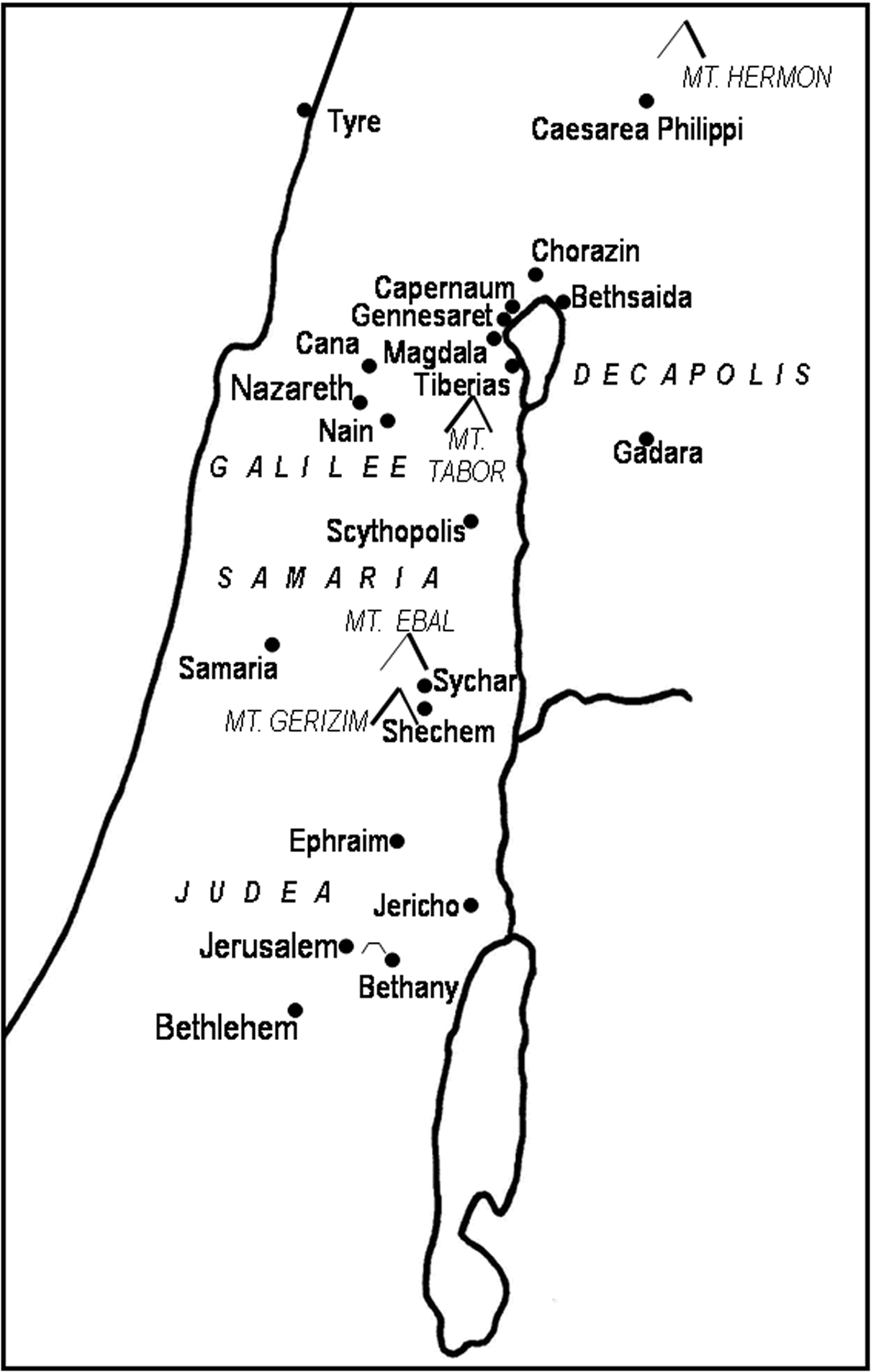 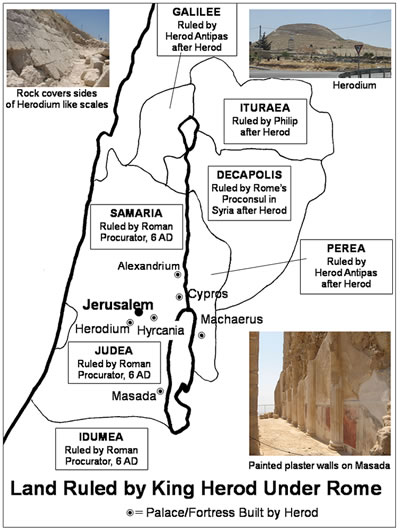
Note: Josephus records that John the Baptist was arrested by Herod Antipas and held at the palace/fortress of Machaerus. (Mt. 14:1-12; Mark 6:14-29; Luke 9:7-9)
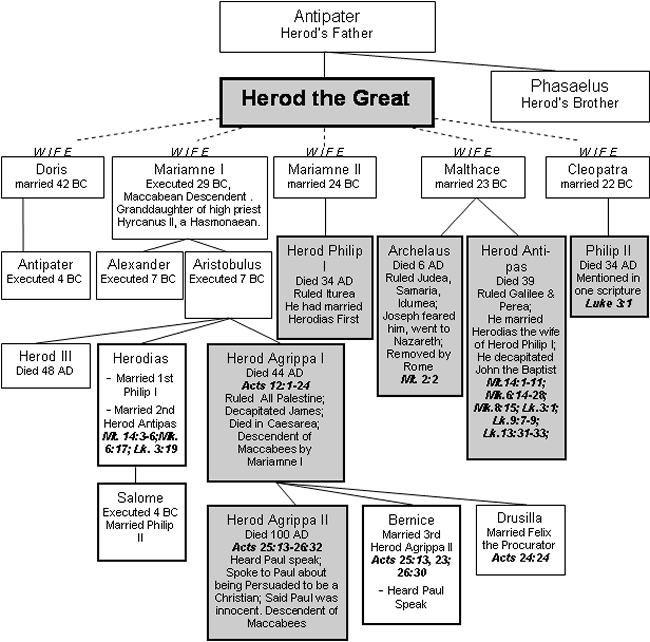
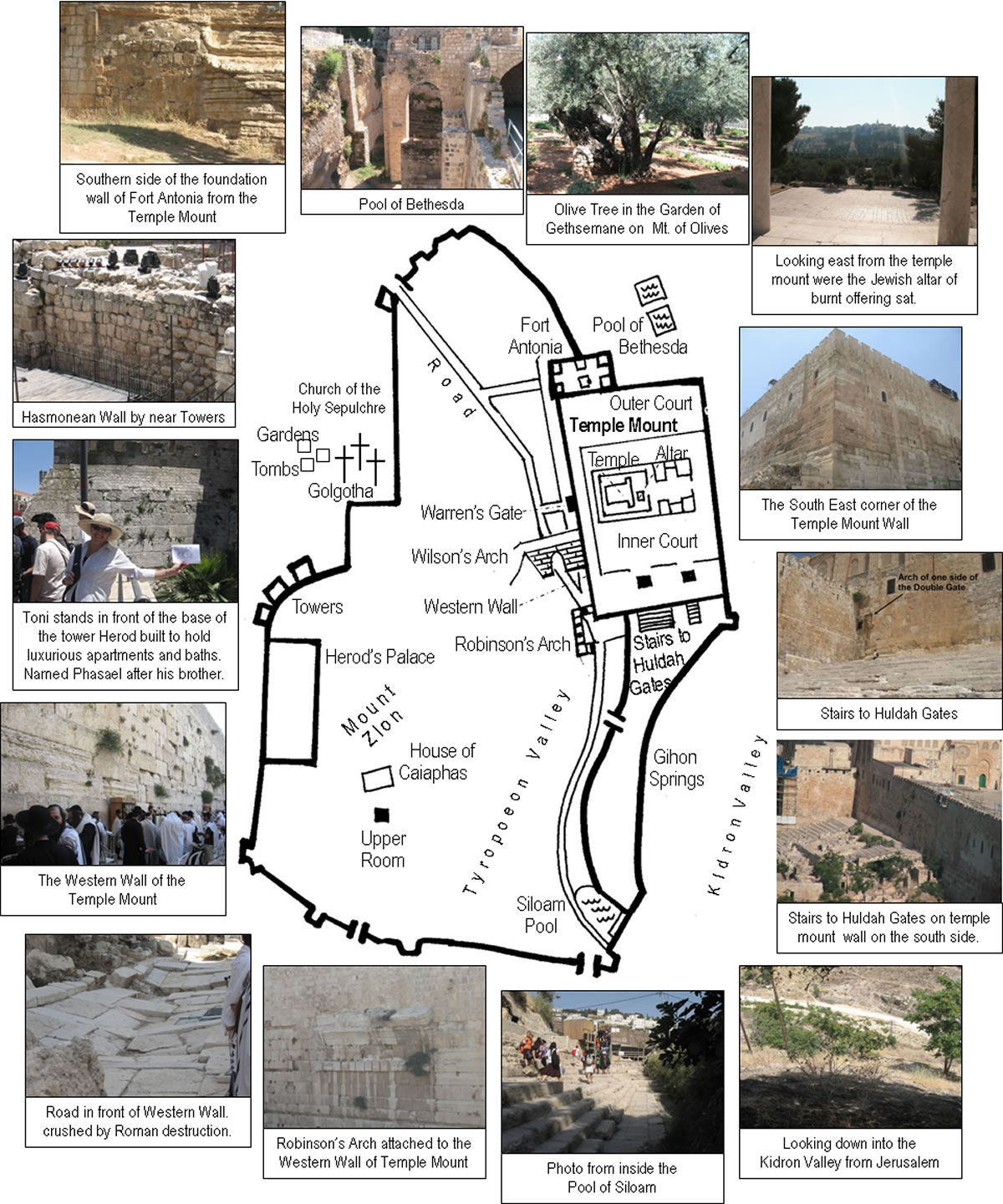
The Life of Christ |
Map A |
Birth, childhood |
|
30 years |
|
6 BC-
25 AD |
|
Map B |
Baptism to Wedding
in Cana |
|
48
days |
|
26 AD |
|
Map C |
Early Judean Ministry |
Jn.2:1-13 |
8 months |
Time of
Introduction |
26 AD |
1st Passover
John 2:13 |
Maps
D, E,
F, G, |
Galilean Ministry |
Mt.4:12-19:1
Mk.1:14-10:1
Lk.4:14-9:51
Jn.4:43-10:22 |
2
years |
Time of
Popularity |
27-28 AD |
2nd & 3rd Passo.
John 5:1; 6:4 |
Map H, I |
Perean and Second Judean Ministry |
Mt.19:1;
Mk.10:1;
Lk.9:51;
Jn.10:22 |
7 months |
Time of
Opposition
|
29 AD
(Oct.15, Dec.25,
April) |
Tabernacles
John 7:2
Hanukkah
John 10:22 |
Map
J, K, L, M, N, O |
The Last Week |
|
7
days |
In Jerusalem |
30 AD |
4th Passover
John 12:1 |
See
Chart |
The Crucifixion |
|
1
day |
Death on
the Cross |
30 AD |
|
See Chart |
Post-Resurrection |
|
40
days |
Resurrection to Ascension |
30 AD |
|
Map A
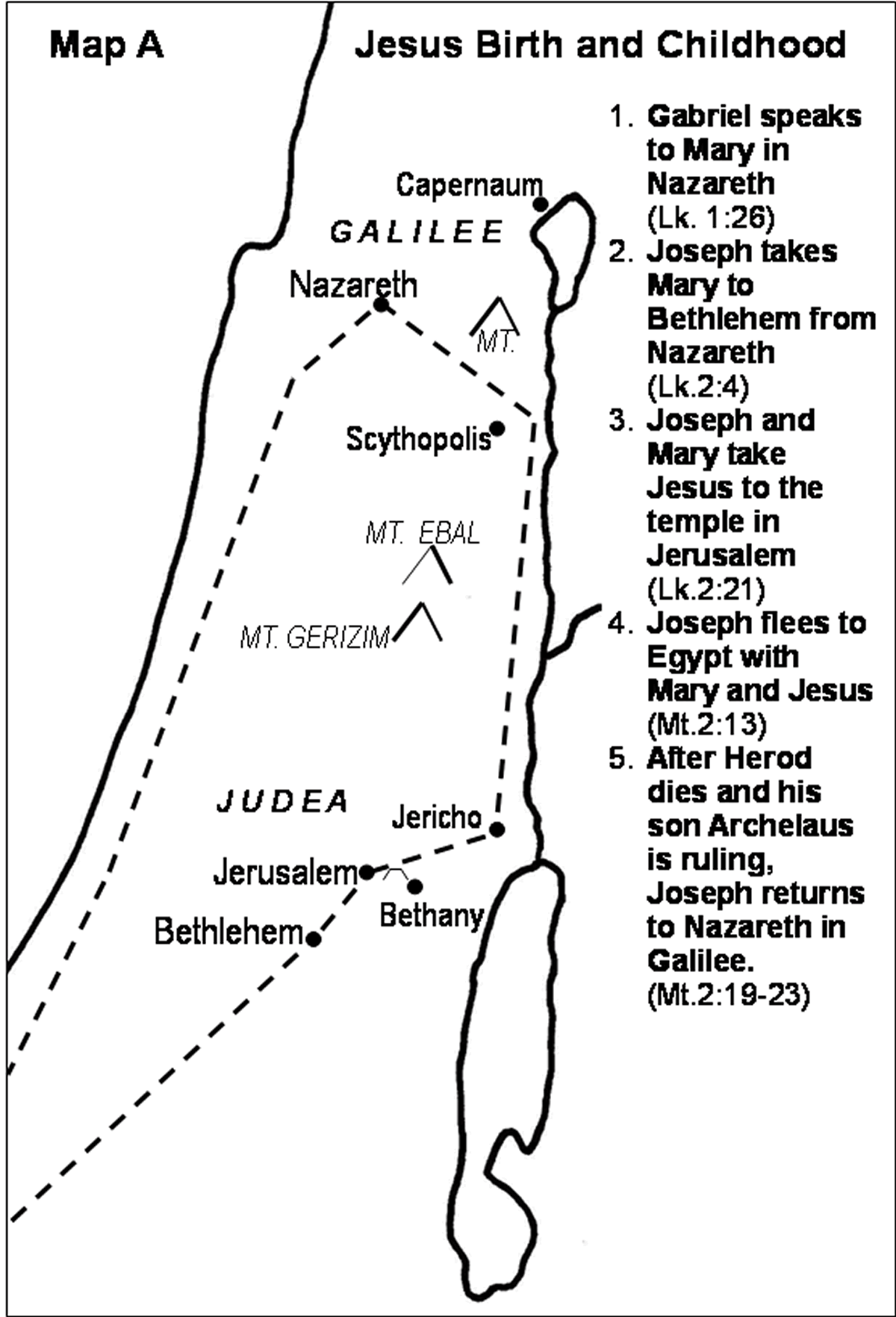 Map B
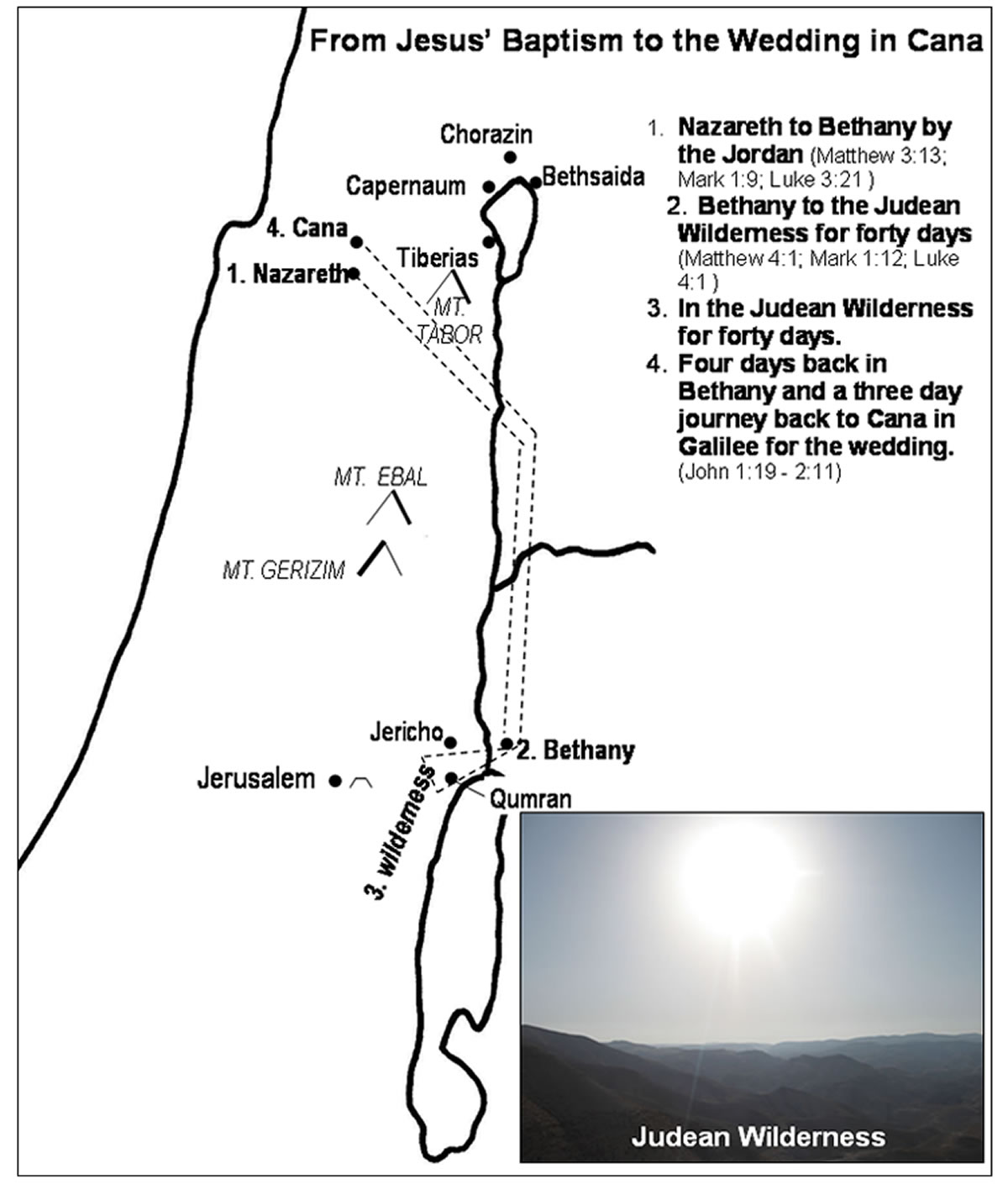 Jesus Baptism to the Wedding at Cana (48 days) – Map A Jesus Baptism to the Wedding at Cana (48 days) – Map A
- Jesus’ Baptism by John – Matthew 3:13; Mark 1:9; Luke 3:21
- Jesus in wilderness for forty days – Matthew 4:1; Mark 1:12; Luke 4:1
- Jesus returns from the wilderness
- Day One back from the wilderness – John 1:19
- Day before Jesus publicly arrives from the wilderness
- John meets with delegation from Jerusalem
- Day Two – John 1:29
- John Introduces Jesus publicly for the first time
- Day Three – John 1:35
- John introduces Andrew and John to Jesus personally
- Day Four – John 1:43
- Jesus leaves for Galilee (Cana)
- Jesus finds Philip on his way North
- Philip finds Nathanael
- Day Five
- Travel to Galilee
- Day Six
- Travel
- Day Seven – John 2:1
- “On the third day a wedding . . .” refers to three days after calling Philip and speaking with Nathanael Jesus and his new disciples arrive at a wedding in Cana.
- Jesus attends the wedding in Cana, Galilee
- Jesus does his first miracle, the sign of turning water to wine
KEY POINTS (back to the top)
OTHER SITES (back to the top)
BOOKS from Galyn's Shelf: (back to the top)
QUESTIONS (back to the top)
TAKE THE TESTS
Chapter Tests:
Sect E, Ch 23 - The Gospels
Essay Tests:
Sect E, Ch 23 - How was Herod a Great Man in the Positive Sense
|